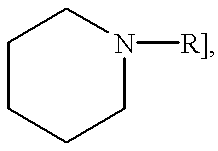Analogs of biologically active, naturally occurring polyamines, pharmaceutical compositions and methods of treatment
a biologically active, naturally occurring technology, applied in the field of polyamines, can solve the problems of inability to further process polyamines, the distance between the charged centers, and the limitation of the earlier method to the terminal primary alkyl group
- Summary
- Abstract
- Description
- Claims
- Application Information
AI Technical Summary
Problems solved by technology
Method used
Image
Examples
example 2
N,N'-Bis (2,4,6-trimethylbenzenesulfonyl)-4-(aminomethyl) piperidine [(2) FIG. 4]
A solution of 2-mesitylenesulfonyl chloride (19.49 g, 89.1 mmol) in CH.sub.2 Cl.sub.2 (100 ml) was added to 4-(aminomethyl)-piperidine (1) (5.15 g, 45.1 mmol) in 1 N NaOH (100 ml) at 0.degree. C. After the addition was complete, the biphasic mixture was stirred for 24 hours (0.degree. C. to room temperature). The layers were separated and the aqueous portion was extracted with CHCl.sub.3 (2 x). The combined organic phase was washed with 0.5 N HCl (200 ml) and H.sub.2 O (100 ml), dried with sodium sulfate and evaporated in vacuo. Recrystallization from aqueous ethanol produced 18.72 g (88%) of (2) as plates: mp 158.5-160.degree. C.; NMR (CDCl.sub.3 / TMS) .delta.0.8-2.0 (m, 5H), 2.25 (s, 6H), 2.46-2.93 (m+2s, 16H), 3.37-3.65 (m, 2H), 4.67 (t, 1H, J=6), 6.90 (s, 4H). Anal. calcd. for C.sub.24 H.sub.34 N.sub.2 O.sub.4 S.sub.2 : C--60.22, H--7.16, N--5.85. Found: C--60.31, H--7.19, N--5.86.
N,N'-1,4-Bis(2,4,6...
example 3
N,N'-Bis(2,4,6-trimethylbenzenesulfonyl)-1,4-butanediamine [(1) FIG. 5]
2-Mesitylenesulfonyl chloride (54.40 g, 0.249 mol) in CH.sub.2 Cl.sub.2 (300 ml) was added to 1,4-diaminobutane (11.34 g, 0.129 mol) in 1 N NaOH (300 ml) at 0.degree. C., and the biphasic mixture was stirred for 24 hours at room temperature. Organic solvent was evaporated and 2.4 N HCl (250 ml) was added to the combined portions. Solid was filtered, washed with water (250 ml) and recrystallized from aqueous ethanol to give 50.46 g (90%) of (1) as needles: mp 156.5-157.5.degree. C.; NMR (CDCl.sub.3 / TMS) .delta.1.36-1.60 (m, 4H), 2.27 (s, 6H), 2.57 (s, 12H), 2.69-2.96 (m, 4H), 4.65 (t, 2H, J=6), 6.89 (s, 4H). Anal. calcd. for C.sub.22 H.sub.32 N.sub.2 O.sub.4 S.sub.2 : C--58.38, H--7.13, N--6.19. Found: C--58.31, H--7.19, N--6.14.
N,O-Bis(2,4,6-trimethylbenzenesulfonyl)-4-piperidineethanol [(2) FIG. 5]
2-Mesitylenesulfonyl chloride (24.78 g, 0.113 mol) in pyridine (60 ml) was added all at once to 4-piperidine-ethano...
PUM
| Property | Measurement | Unit |
|---|---|---|
| Distance | aaaaa | aaaaa |
Abstract
Description
Claims
Application Information
 Login to View More
Login to View More - R&D
- Intellectual Property
- Life Sciences
- Materials
- Tech Scout
- Unparalleled Data Quality
- Higher Quality Content
- 60% Fewer Hallucinations
Browse by: Latest US Patents, China's latest patents, Technical Efficacy Thesaurus, Application Domain, Technology Topic, Popular Technical Reports.
© 2025 PatSnap. All rights reserved.Legal|Privacy policy|Modern Slavery Act Transparency Statement|Sitemap|About US| Contact US: help@patsnap.com



